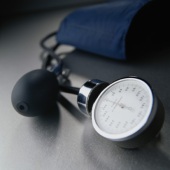- Understanding the Connection Between Anxiety and Depression
- How Daily Prunes Can Influence Cholesterol and Inflammation
- When to Take B12 for Better Absorption and Energy
- Epsom Salts: Health Benefits and Uses
- See What Saffron Can Do for Sleep and Heart Health
- 6 Common Mistakes to Avoid Before Your Physical
- Can Sweating Really Help You Beat a Cold?
- Strengthening Your Relationship: Practical Strategies
- Skip Storing This Everyday Product in the Fridge Door
- Green Tea + B3 Pairing May Boost Brain Health
ER Visits Up for High Blood Pressure


Emergency room visits for high blood pressure jumped 25 percent in the United States in recent years, according to a new study.
The finding — based on nearly 4 million U.S. emergency room visits from 2006 to 2011 — points to a need for people to better control their blood pressure by going to their primary care doctor, said Dr. Sourabh Aggarwal, the study’s lead researcher.
“That’s quite a big increase in the number of visits to the ER,” said Aggarwal, chief resident in internal medicine at the Western Michigan University School of Medicine in Kalamazoo.
However, while ER visits jumped, hospital admissions for high blood pressure, or hypertension, fell by 15 percent, the researchers said.
And deaths among those admitted to the hospital because of blood pressure spikes fell 36 percent, the investigators found.
Aggarwal can’t say what lies behind the findings, as the data didn’t include detailed information.
But he speculated that patients found to have high blood pressure in the ER may not have a regular doctor. In some cases, the high blood pressure gets detected when they seek care for another complaint, he noted.
The finding that fewer admissions and deaths are occurring could indicate that emergency room and hospital doctors have become better at treating high blood pressure, Aggarwal suggested.
For the study, researchers collected information from a nationwide emergency department database and looked for high blood pressure as the first diagnosis.
ER visits because of high blood pressure jumped from 71 per every 100,000 people in 2006 to nearly 85 per 100,000 in 2011, the study found.
One expert said the results suggest a change in health-care patterns rather than an alarming spike in Americans’ blood pressure levels.
“What this is a sign of is that patients are going to the ER instead of their doctor,” said Dr. Stephen Pitts, associate professor of medicine at Emory University in Atlanta, who wasn’t involved in the study.
Pitts added that the study has some weaknesses because of the database used. “It’s a database of financial claims and might be susceptible to bias,” he said. The apparent boost in blood pressure visits might actually reflect changes in billing patterns, he noted.
Or, at the end of an ER visit, if doctors don’t have a precise diagnosis but they detected high blood pressure, that is what they might write down, he said.
Pitts said he doubts that aging of the baby boom generation or widespread obesity are behind the increase because the time period studied was short.
Aggarwal is scheduled to present the findings Tuesday at an American Heart Association meeting on high blood pressure in San Francisco. Data and conclusions of research presented at medical meetings are typically viewed as preliminary until published in a peer-reviewed journal.
According to the heart association, about one out of every three U.S. adults has high blood pressure, which is a risk factor for stroke, heart attack and heart failure. It’s called a “silent killer” because it typically has no symptoms.
Optimal blood pressure is below 120/80 mm Hg. The top number measures pressure in the arteries when the heart beats, while the bottom number measures pressure in the arteries between heartbeats.
The heart association recommends emergency care if blood pressure measured at home tops 180/110 mm Hg. That is considered a hypertensive crisis.
More information
For more about high blood pressure, visit the American Heart Association.
Source: HealthDay
Copyright © 2026 HealthDay. All rights reserved.










